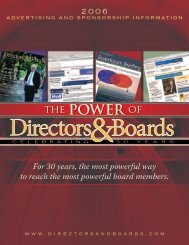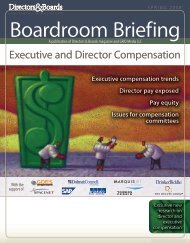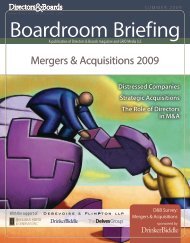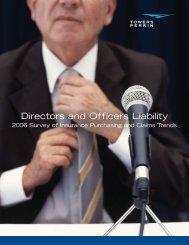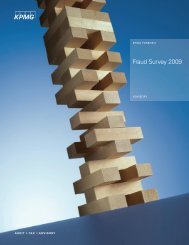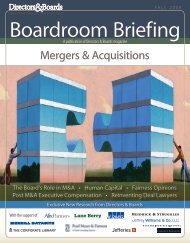The LRN ethics and compliance risk management practices report
The LRN ethics and compliance risk management practices report
The LRN ethics and compliance risk management practices report
Create successful ePaper yourself
Turn your PDF publications into a flip-book with our unique Google optimized e-Paper software.
Ot<br />
Workforce Outreach<br />
Workforce Outreach<br />
DETAILED RESULTS<br />
US<br />
Despite challenges, companies reach all or most of their employees across the world with<br />
100%<br />
their education <strong>and</strong> certification programs. This accomplishment is achieved despite the<br />
significant number of workers that can be difficult to reach in industries with large offline<br />
populations such as agriculture, energy, manufacturing, retail, transportation <strong>and</strong> sales<br />
75%<br />
where workers spend the majority of their time in the “field,” without either ready-access to<br />
an Internet kiosk or in a setting that makes it difficult to receive education consistently. <strong>The</strong>se<br />
50%<br />
results are nearly the same as 2007.<br />
<strong>The</strong> single data point worth noting is that Asia has the highest level of “some” employees.<br />
25%<br />
Given that<br />
US<br />
more <strong>and</strong> more companies utilize manufacturing or business partnerships in Asia,<br />
Canada/ Mexico<br />
Europe<br />
this Canada/ might Mexico indicate a need to ensure better<br />
South Am/<br />
efforts<br />
Carribean<br />
All employees Europe<br />
to provide Asia/ Pacific education to workers in that<br />
South Am/ Carribean<br />
Africa<br />
0%<br />
Asia/ Pacific<br />
region of<br />
Most<br />
the<br />
employees<br />
Africa<br />
world.<br />
Middle East<br />
All employees<br />
Most employees All or Most Employees Subtotal<br />
All or Most Employees Some Subtotal employees<br />
Some employeesNo employees<br />
No employees<br />
Some or No Employees Subtotal<br />
9. Do you Some provide or No Employees <strong>ethics</strong> Subtotal <strong>and</strong> <strong>compliance</strong> education <strong>and</strong>/or certification activities/<br />
programs to the following<br />
Middle East<br />
100%<br />
75%<br />
50%<br />
25%<br />
0%<br />
More companies reach white collar workers than Boards, blue collar <strong>and</strong> service<br />
workers.<br />
Ethics <strong>and</strong> Compliance Educational Programs Outreach<br />
Ethics <strong>and</strong> Compliance Educational Programs Outreach<br />
% Respondents<br />
% Respondents<br />
Inade<br />
0% 25% 50% 75% 100%<br />
0% 25% 50% 75% 100%<br />
Making the ed<br />
Cu<br />
White collar: Professional, Managerial 94%<br />
White collar: Professional, Managerial 94%<br />
Regul<br />
White collar: Sales, Clerical 89%<br />
Lo<br />
White collar: Sales, Clerical 89%<br />
Low employee enga<br />
Board of Directors 70%<br />
Board of Directors 70%<br />
Knowing all our<br />
Blue collar: Craftsman, Foreman 67%<br />
Lack of<br />
Blue collar: Craftsman, Foreman 67%<br />
Lack of E/C materials in<br />
Service workers 64%<br />
Service workers 64%<br />
Techn<br />
Blue collar: Semiskilled, Unskilled 62%<br />
Blue collar: Semiskilled, Unskilled 62%<br />
Business Partners 36%<br />
Business Partners 36%<br />
Lack of transla<br />
Low le<br />
Suppliers 25%<br />
Suppliers 25%<br />
Resellers 12%<br />
Resellers 12%<br />
Given that it is easier to reach white collar professional <strong>and</strong> managerial workers, it is logical<br />
that most companies are successful providing education to them. However, the substantial<br />
declines of roughly 30 percentage points in reaching blue collar skilled workers, service<br />
workers, <strong>and</strong> blue collar semi-skilled workers is disconcerting given that regulations require<br />
companies to encourage an ethical corporate culture <strong>and</strong> establish effective <strong>compliance</strong><br />
programs across the entire workforce. Companies face greater challenges to engage these<br />
types of workers <strong>and</strong> make <strong>ethics</strong> <strong>and</strong> <strong>compliance</strong> relevant to their jobs.<br />
Few enterprises provide education to their extended business ecosystem.<br />
<strong>The</strong> low survey results regarding educating the business ecosystem, indicates a lack of focus<br />
on this area. <strong>The</strong>y will become increasingly important populations for effective <strong>ethics</strong> <strong>and</strong><br />
<strong>compliance</strong> education as companies outsource manufacturing <strong>and</strong> sales, as well as create<br />
partnerships around the world. Given that the U.S. Federal Sentencing Guidelines encourage<br />
large organizations to ensure smaller partners “implement effective <strong>compliance</strong> <strong>and</strong> <strong>ethics</strong><br />
programs,” companies should invest in reaching them. Recent updates to the Federal<br />
Acquisition Regulations (FAR), require any prime contractor – <strong>and</strong> subcontractor – with<br />
$5 million dollars in annual government contracts have a code of conduct, communicate<br />
<strong>LRN</strong> | 2008 Ethics <strong>and</strong> Compliance Risk Management Practices Report | 29



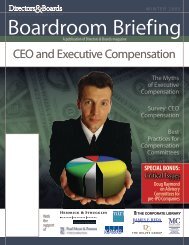
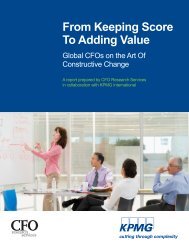
![[link to PDF] for a copy of the briefing paper - Directors & Boards](https://img.yumpu.com/43729022/1/190x245/link-to-pdf-for-a-copy-of-the-briefing-paper-directors-boards.jpg?quality=85)
